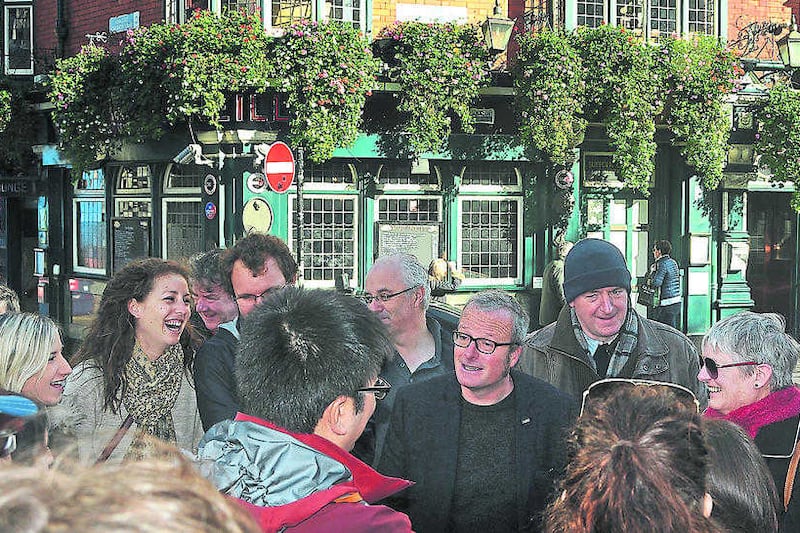1916: The Rising Handbook by Lorcan Collins, published by O'Brien
IF YOU only buy one title about the Easter Rising, it should be Lorcan Collins's 1916: The Rising Handbook.
You might think that lists of names and facts about everything from the weapons to the garrisons could be old fashioned or even dull but the book is strangely moving. Reading the account of the execution of the 16 leaders of the Rising, for example, we are reminded of how the badly wounded James Connolly was shot by firing squad while strapped to a chair – although Collins's prose is spare, the detail is affecting.
As the author points out, the Handbook doesn't merely repeat the history, it contains new material.
"It's the first book to publish the names of the 2,500 who won the 1916 medal, issued by the Irish government in 1941. It's also the first book to list all 276 of the women involved in the Rising. And it contains a full interpretation of the 1936 roll of honour."
The Handbook has one or two quirky sidebars to the main history – for example, the anecdote about Elvery's cricket bat. Bullets landed in many areas during the Rising, but surprisingly one lodged in a cricket bat originally on display at the shop window of John W Elvery and Co in Lower Sackville Street. Five men were positioned nearby, but they came under intense fire and were then ordered to withdraw to the GPO. Later, somebody inscribed 'Easter Week, 1916, Front Window' just beside the bullet.
The letters written by the 16 Leaders to family and friends once they knew their fate provide a moving demonstration of their courage. Patrick Pearse's first letter is quoted in the Handbook under Statements and Last Testimonies. He wrote "My dear Mother, I know you will have been longing to hear from me." and ends "If you would like to see me, I think you will be allowed to visit me by applying to the Headquarters, Irish Command, near the Park. I shall I hope have another opportunity of writing to you.
Love to W.W., MB, Miss Byrne... and your own dear self. P."
There are revealing details of the aftermath of the Rising and the destinations of the many men taken prisoner. The Prisoner Lists in Section Eleven indicate two groups of prisoners numbering 273, then 100, were sent to Wakefield in Yorkshire, 211 to Richmond Barracks and 197 to Glasgow and Perth, with the names of those involved.
Collins (46) says that it was a accident of geography that originally sparked his interest in Ireland's bid for independence. As a child, he lived next to some land owned by the Plunketts, the family of Rising leader Joseph Plunkett.
"I grew up right beside Larkfield," he says of the Plunkett family's estate in Kimmage, south west of Dublin city centre. "The Plunketts offered accommodation there a few months before the Rising to men avoiding conscription. Michael Collins was one of them."
At 11 the precocious Collins – Lorcan, not Michael – began to look into Irish history.
"This was around 1981, a very political period with the Hunger Strikes going on. I also had a grandfather in the IRA – Laurence, although everyone called him Lar. I remember being quite fascinated by his tales. He told me about escaping from a train during the Civil War while being taken to a prison camp."
As Collins explains, the soldiers had taken the prisoners' clothes but the men managed to get out by smashing a window. "They were practically naked and had cuts from the glass but fortunately the person whose house they approached happened to be republican."
After attending Drimnagh Castle Christian Brothers' School – "it sounds fancy but was a good old working class school, all lads" – Collins started work. He later took a degree in English Literature. His day job is related to his published work as 20 years ago he set up in business offering 1916 walking tours around Dublin. Today he regularly escorts groups of 30, many of them Irish.
Collins's aim, in the book as in his historical tours, was to set the record straight. One detail that's always written into the Rising legend is that the 1916 Proclamation of the Irish Republic was read out on the steps of the GPO by Pearse. In fact, it couldn't have been as the Graeco-Roman Post Office building has no steps, simply a modest kerb.
Collins says: "Romantic details have been added and the Proclamation you see reproduced in papers and elsewhere is often the wrong one. This is a nerdy detail but it was fixed up by The Irish Times printer in the aftermath of the Rising and the R is slightly broken."
He defends the message of the document itself.
"What I always say to people from the unionist tradition is that they should study the Proclamation for five minutes and show me where it says they're excluded."
And he says that his research into some of the weapons deployed brought surprises. "The British used 18-pounders which were inaccurate anti-personnel weapons with shrapnel inside. Hell rained down on you."
It's a complex period of Irish history involving all parts of the island and the book covers events in Belfast and Tyrone. The IRB president, Belfast native Denis McCullough, funded a man called Archie Heron who disguised his allegiance and supplied Irish Volunteers with military equipment via a UVF store.
Later, 132 of these Volunteers mobilised on April 22, with the intention of heading for Galway under Pearse's orders.
We bat about the alternative-history version of the Easter Rising. "If the 20,000 weapons [bound for the revolutionaries from Germany aboard the ill-fated Aud] had landed and there had been more support, it would have altered the course of European history," Collins offers.
:: For details of the 1916 Rebellion Walking Tours see www.1916 rising.com.


